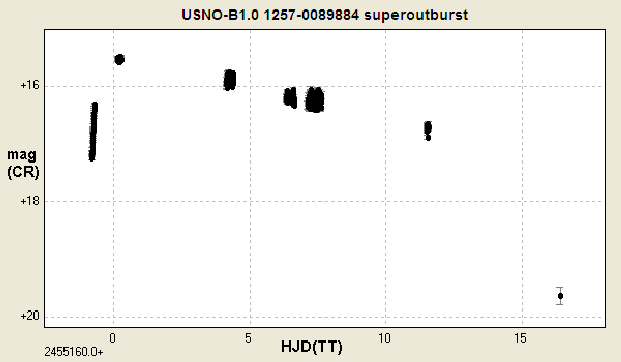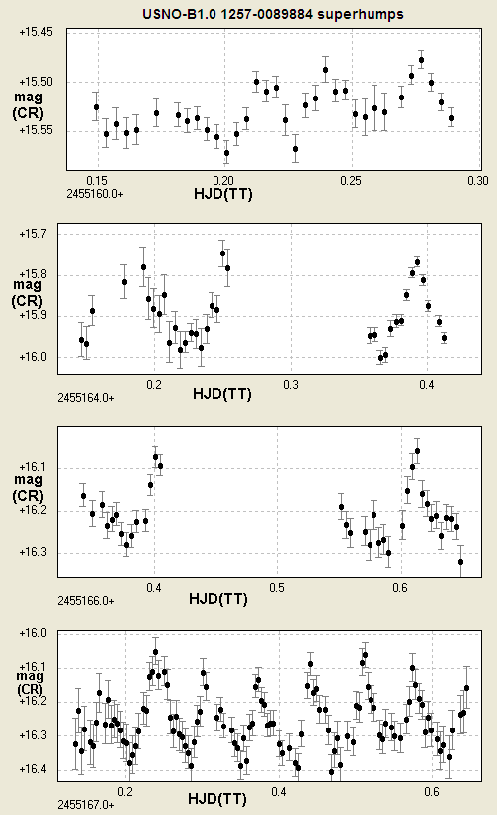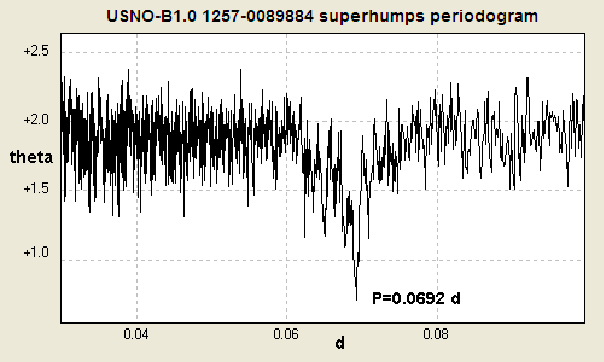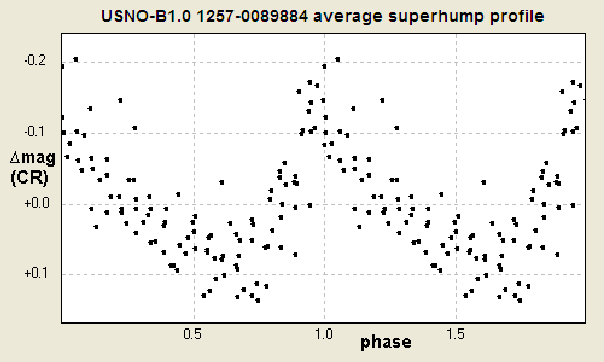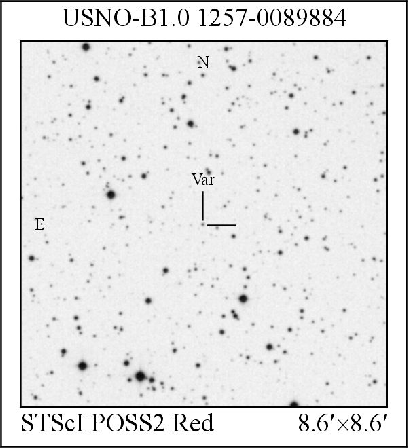|
Peremennye Zvezdy (Variable Stars) 30, No. 1, 2010 Received 07 December; accepted 12 January.
|
Article in PDF |
The New SU UMa Dwarf Nova USNO-B1.0 1257-0089884
T. Kryachko1, A. Samokhvalov2, B. Satovskiy1, A. Prokopovich3
- Astrotel Observatory, Karachay-Cherkessiya, Russia;
e-mail: bredfild@mail.ru, bs25@mail.ru
- Surgut, Russia;
e-mail: sav@surgut.ru
- Grodno, Belarussia; e-mail: doctorandrey@mail.ru
| We present our discovery of a new dwarf nova USNO-B1.0 1257-0089884. The object showed superhumps, which establish that it is an UGSU variable star. All observations were acquired at the Astrotel-Caucasus Observatory. |
During observations of the field of SAO 57626, we discovered a
new SU UMa dwarf nova USNO-B1.0 1257-0089884 (Kryachko and
Prokopovich 2009). Its UNSO-B1.0 coordinates are:
05![]() 06
06![]() 17
17![]() 35, +35
35, +35![]() 47
47![]() 38
38
![]() 8 (J2000.0).
8 (J2000.0).
Our observations were carried out at the Astrotel-Caucasus
observatory using the 300-mm Ritchey-Chretien telescope, equipped
with an unfiltered Apogee Alta U9000 CCD camera. A total of 727
images with 5-minute exposures were obtained on JD
2455119-2455176. For basic reductions for dark current, flat
fields, and bias, we used IRAF routines. For photometry of the new
dwarf nova, we applied VaST software by Sokolovsky and Lebedev
(2005). The comparison star was USNO-A2.0 1200-02802479 =
USNO-B1.0 1257-0088583 (05![]() 04
04![]() 28
28![]() 58,
+35
58,
+35![]() 45
45![]() 24
24
![]() 6, 2000.0, 2MASS;
6, 2000.0, 2MASS;
![]() ,
,
![]() , USNO-B1.0). Unfiltered magnitudes were calibrated
using the comparison star, assuming
, USNO-B1.0). Unfiltered magnitudes were calibrated
using the comparison star, assuming
![]() .
.
For observations on JD 2455171, the comparison star was USNO-A2.0
1200-02865310 = USNO-B1.0 1256-0089465 (05![]() 07
07![]() 07
07![]() 00,
+35
00,
+35![]() 40
40![]() 03
03
![]() 1, 2000.0, 2MASS;
1, 2000.0, 2MASS;
![]() ,
,
![]() , USNO-B1.0). Unfiltered magnitudes on JD 2455171
were calibrated using the comparison star, assuming
, USNO-B1.0). Unfiltered magnitudes on JD 2455171
were calibrated using the comparison star, assuming
![]() .
.
Our observations are available electronically here.
Figure 1 shows the overall light curve of the superoutburst in
November-December, 2009. The object was increasing its brightness
on JD 2455159 at a rate of 0![]() 35 per hour.
35 per hour.
From JD 2455160 to JD 2455167, we observed repetitive superhumps, characterized in Table 1.
| JD | Amplitude, mag |
| 2455160.22 | 0.05 |
| 2455164.28 | 0.18 |
| 2455166.49 | 0.18 |
| 2455167.39 | 0.28 |
Enlarged light curves for JD 2455160-2455167 are shown in Fig. 2.
Using Peranso software (http://www.peranso.com), we performed a
period analysis with Renson's period search algorithm (Renson
1978) for JD 2455160-2455167; the periodogram is shown in Fig. 3.
The best period of the superhumps is
![]() ,
typical of SU UMa stars. The mean superhump profile on JD 2455167
(118 observations) is shown in Fig. 4.
,
typical of SU UMa stars. The mean superhump profile on JD 2455167
(118 observations) is shown in Fig. 4.
The finding chart, based on the POSS-II ![]() plate taken on
JD 2447497, is presented in Fig. 5. The star appears to be in an
outburst on this plate. It is invisible on the POSS-II
plate taken on
JD 2447497, is presented in Fig. 5. The star appears to be in an
outburst on this plate. It is invisible on the POSS-II ![]() plate
taken on JD 2449283, POSS-II IR plate of JD 2450751, or POSS-I
plate
taken on JD 2449283, POSS-II IR plate of JD 2450751, or POSS-I ![]() plate of JD 2435107.
plate of JD 2435107.
Acknowledgements: We would like to thank S. V. Antipin and N. N. Samus for helpful discussion.
References:
Kryachko, T., Prokopovich, A., 2009, vsnet-alert, No. 11686
Renson, P., 1978, A&A, 63, 125
Sokolovsky, K., Lebedev, A., 2005, in 12th Young Scientists' Conference on Astronomy and Space Physics, Kyiv, Ukraine, April 19-23, 2005, eds.: Simon, A., Golovin, A., p.79
